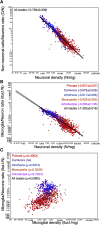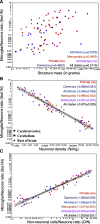Similar Microglial Cell Densities across Brain Structures and Mammalian Species: Implications for Brain Tissue Function
- PMID: 32253358
- PMCID: PMC7294795
- DOI: 10.1523/JNEUROSCI.2339-19.2020
Similar Microglial Cell Densities across Brain Structures and Mammalian Species: Implications for Brain Tissue Function
Abstract
Microglial cells play essential volume-related actions in the brain that contribute to the maturation and plasticity of neural circuits that ultimately shape behavior. Microglia can thus be expected to have similar cell sizes and even distribution both across brain structures and across species with different brain sizes. To test this hypothesis, we determined microglial cell densities (the inverse of cell size) using immunocytochemistry to Iba1 in samples of free cell nuclei prepared with the isotropic fractionator from brain structures of 33 mammalian species belonging to males and females of five different clades. We found that microglial cells constitute ∼7% of non-neuronal cells in different brain structures as well as in the whole brain of all mammalian species examined. Further, they vary little in cell density compared with neuronal cell densities within the cerebral cortex, across brain structures, across species within the same clade, and across mammalian clades. As a consequence, we find that one microglial cell services as few as one and as many as 100 neurons in different brain regions and species, depending on the local neuronal density. We thus conclude that the addition of microglial cells to mammalian brains is governed by mechanisms that constrain the size of these cells and have remained conserved over 200 million years of mammalian evolution. We discuss the probable consequences of such constrained size for brain function in health and disease.SIGNIFICANCE STATEMENT Microglial cells are resident macrophages of the CNS, with key functions in recycling synapses and maintaining the local environment in health and disease. We find that microglial cells occur in similar densities in the brains of different species and in the different structures of each individual brain, which indicates that these cells maintain a similar average size in mammalian evolution, suggesting in turn that the volume monitored by each microglial cell remains constant across mammals. Because the density of neurons is highly variable across the same brain structures and species, our finding implies that microglia-dependent functional recovery may be particularly difficult in those brain structures and species with high neuronal densities and therefore fewer microglial cells per neuron.
Keywords: cell density; cell numbers; comparative; evolution; microglia.
Copyright © 2020 the authors.
Figures







Similar articles
-
Not all brains are made the same: new views on brain scaling in evolution.Brain Behav Evol. 2011;78(1):22-36. doi: 10.1159/000327318. Epub 2011 Jun 17. Brain Behav Evol. 2011. PMID: 21691045 Review.
-
Mammalian Brains Are Made of These: A Dataset of the Numbers and Densities of Neuronal and Nonneuronal Cells in the Brain of Glires, Primates, Scandentia, Eulipotyphlans, Afrotherians and Artiodactyls, and Their Relationship with Body Mass.Brain Behav Evol. 2015;86(3-4):145-63. doi: 10.1159/000437413. Epub 2015 Sep 30. Brain Behav Evol. 2015. PMID: 26418466
-
Cellular Scaling Rules for the Brains of Marsupials: Not as "Primitive" as Expected.Brain Behav Evol. 2017;89(1):48-63. doi: 10.1159/000452856. Epub 2017 Jan 27. Brain Behav Evol. 2017. PMID: 28125804
-
Phylogenetic variation in cortical layer II immature neuron reservoir of mammals.Elife. 2020 Jul 21;9:e55456. doi: 10.7554/eLife.55456. Elife. 2020. PMID: 32690132 Free PMC article.
-
Variability in neuron densities across the cortical sheet in primates.Brain Behav Evol. 2011;78(1):37-50. doi: 10.1159/000327319. Epub 2011 Jun 17. Brain Behav Evol. 2011. PMID: 21691046 Review.
Cited by
-
Microglia-derived TGF-β1 ligand maintains microglia homeostasis via autocrine mechanism and is critical for normal cognitive function in adult mouse brain.bioRxiv [Preprint]. 2023 Jul 7:2023.07.05.547814. doi: 10.1101/2023.07.05.547814. bioRxiv. 2023. Update in: Nat Commun. 2024 Jun 21;15(1):5306. doi: 10.1038/s41467-024-49596-0. PMID: 37461569 Free PMC article. Updated. Preprint.
-
Neurodevelopment of the association cortices: Patterns, mechanisms, and implications for psychopathology.Neuron. 2021 Sep 15;109(18):2820-2846. doi: 10.1016/j.neuron.2021.06.016. Epub 2021 Jul 15. Neuron. 2021. PMID: 34270921 Free PMC article. Review.
-
Transplanting Microglia for Treating CNS Injuries and Neurological Diseases and Disorders, and Prospects for Generating Exogenic Microglia.Cell Transplant. 2023 Jan-Dec;32:9636897231171001. doi: 10.1177/09636897231171001. Cell Transplant. 2023. PMID: 37254858 Free PMC article. Review.
-
The Two Faces of HDAC3: Neuroinflammation in Disease and Neuroprotection in Recovery.Epigenomics. 2024 Nov-Nov;16(21-22):1373-1388. doi: 10.1080/17501911.2024.2419357. Epub 2024 Nov 8. Epigenomics. 2024. PMID: 39513228 Review.
-
Human-specific paralogs of SRGAP2 induce neotenic features of microglia structural and functional maturation.bioRxiv [Preprint]. 2024 Jun 29:2024.06.28.601266. doi: 10.1101/2024.06.28.601266. bioRxiv. 2024. PMID: 38979266 Free PMC article. Preprint.
References
-
- Askew K, Li K, Olmos-Alonso A, Garcia-Moreno F, Liang Y, Richardson P, Tipton T, Chapman MA, Riecken K, Beccari S, Sierra A, Molnár Z, Cragg MS, Garaschuk O, Perry HV, Gomez-Nicola D (2017) Coupled proliferation and apoptosis maintain the rapid turnover of microglia in the adult brain. Cell Rep 18:391–405. 10.1016/j.celrep.2016.12.041 - DOI - PMC - PubMed
Publication types
MeSH terms
Grants and funding
LinkOut - more resources
Full Text Sources
Other Literature Sources
Research Materials
